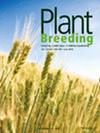Genetic adaptation of phenological stages in Chinese and European elite soybeans (Glycine max [L.] Merr.) across latitudes in Central Europe
IF 1.8
4区 农林科学
Q2 AGRONOMY
引用次数: 0
Abstract
Genetic adaptation of soybean phenological stages to high‐latitude long‐day environments is the major pre‐requisite for enhancing regional plant‐based protein production. Both中国和欧洲精英大豆(Glycine max [L.] Merr.
大豆物候期对高纬度长日照环境的遗传适应是提高地区植物性蛋白质产量的主要前提。控制开花的 E 基因和生长环境都决定了大豆开花和成熟的时间,而中国大豆和欧洲大豆的 E 基因组成可能存在差异,这有可能提高大豆的适应性。因此,对中国或欧洲的 140 个早熟优良大豆栽培品种的 E1 至 E4 开花基因座进行了基因分型,并在北纬 45 至 52° 的 17 个欧洲环境中对基因型进行了测试,以确定各种 E 基因等位基因组合的影响。中国和欧洲栽培品种之间的 E-等位基因组成差异在 E1 和 E3 位点上最大。野生型等位基因会明显延迟开花,而特定 E-等位基因的影响则取决于地理纬度。因此,携带多个无功能等位基因的对光周期不敏感的E单倍型被证明适合在较高纬度地区种植,而对光周期敏感的晚熟E单倍型只适应较低纬度地区。因此,通过结合中国和欧洲的等位基因培育新的 E 单倍型可提高大豆进一步适应北方种植区的潜力。
本文章由计算机程序翻译,如有差异,请以英文原文为准。
求助全文
约1分钟内获得全文
求助全文
来源期刊

Plant Breeding
农林科学-农艺学
CiteScore
4.40
自引率
5.00%
发文量
74
审稿时长
3.0 months
期刊介绍:
PLANT BREEDING publishes full-length original manuscripts and review articles on all aspects of plant improvement, breeding methodologies, and genetics to include qualitative and quantitative inheritance and genomics of major crop species. PLANT BREEDING provides readers with cutting-edge information on use of molecular techniques and genomics as they relate to improving gain from selection. Since its subject matter embraces all aspects of crop improvement, its content is sought after by both industry and academia. Fields of interest: Genetics of cultivated plants as well as research in practical plant breeding.
 求助内容:
求助内容: 应助结果提醒方式:
应助结果提醒方式:


